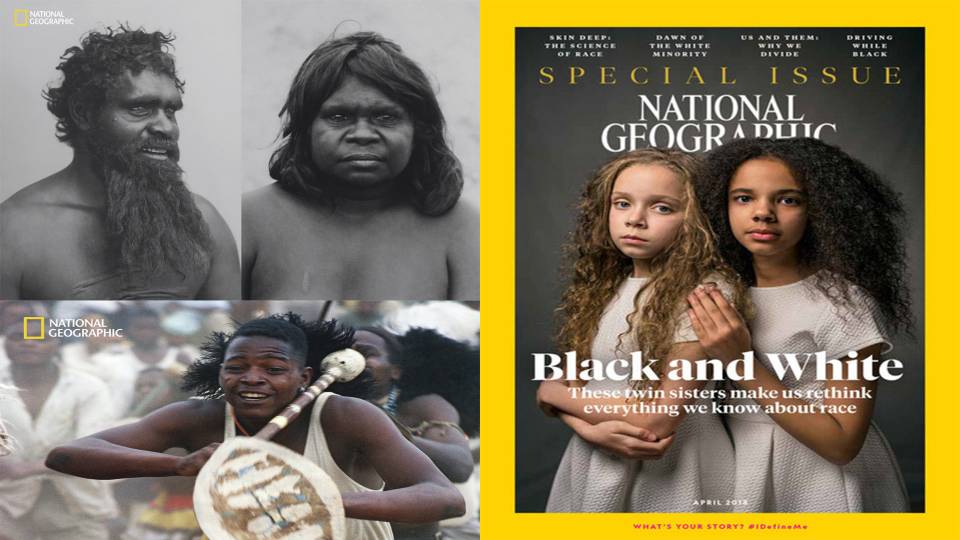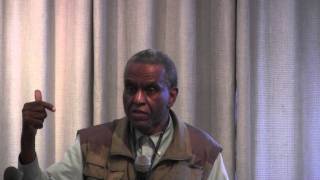'National Geographic' Reckons with Its Past: 'For Decades, Our Coverage Was Racist'
If National Geographic's April issue was going to be entirely devoted to the subject of race, the magazine decided it had better take a good hard look at its own history.
Editor in Chief Susan Goldberg asked John Edwin Mason, a professor of African history and the history of photography at the University of Virginia, to dive into the magazine's nearly 130-year archive and report back.
What Mason found was a long tradition of racism in the magazine's coverage: in its text, its choice of subjects, and in its famed photography.
"[U]ntil the 1970s National Geographic all but ignored people of color who lived in the United States, rarely acknowledging them beyond laborers or domestic workers," writes Goldberg in the issue's editor letter, where she discusses Mason's findings. "Meanwhile it pictured 'natives' elsewhere as exotics, famously and frequently unclothed, happy hunters, noble savages—every type of cliché."
Unlike magazines such as Life, "National Geographic did little to push its readers beyond the stereotypes ingrained in white American culture," Goldberg says, noting that she is the first woman and first Jewish person to helm the magazine – "two groups that also once faced discrimination here."
To assess the magazine's coverage historically, Mason delved into old issues and read a couple of key critical studies. He also pored over photographers' contact sheets, giving him a view of not just the photos that made it into print, but also the decisions that photographers and editors made.
He saw a number of problematic themes emerge.
"The photography, like the articles, didn't simply emphasize difference, but made difference ... very exotic, very strange, and put difference into a hierarchy," Mason tells NPR. "And that hierarchy was very clear: that the West, and especially the English-speaking world, was at the top of the hierarchy. And black and brown people were somewhere underneath."
For much of its history, the pages of National Geographic depicted the Western world as dynamic, forward-moving and very rational. Meanwhile, Mason says, "the black and brown world was primitive and backwards and generally unchanging."
One trope that he noticed time and again was photographs showing native people apparently fascinated by Westerners' technology.
"It's not simply that cameras and jeeps and airplanes are present," he says. "It's the people of color looking at this technology in amusement or bewilderment." The implication was that Western readers would find humor in such fascination with their everyday goods.
Then there's how the magazine chose its subject matter. Mason explains that National Geographic had an explicit editorial policy of "nothing unpleasant," so readers rarely saw war, famine or civic conflict.
He points to an article on South Africa from the early 1960s that barely mentions the Sharpeville Massacre, in which 69 black South Africans were killed by police.
"There are no voices of black South Africans," Mason told Goldberg. "That absence is as important as what is in there. The only black people are doing exotic dances ... servants or workers. It's bizarre, actually, to consider what the editors, writers, and photographers had to consciously not see."
Then there's the way women of color were often depicted in the magazine: topless.
"Teenage boys could always rely, in the '50s and '60s, on National Geographic to show them bare-breasted women as long as the women had brown or black skin," Mason says. "I think the editors understood this was frankly a selling point to its male readers. Some of the bare-breasted young women are shot in a way that almost resembles glamour shots."
Mason says the magazine has been dealing with its history implicitly for the last two or three decades, but what made this project different is that Goldberg wanted to make reckoning explicit — "That National Geographic should not do an issue on race without understanding its own complicity in shaping understandings of race and racial hierarchy."
For those of us who have spent long afternoons thumbing old issues of the magazine and dreaming of far-off lands, Mason wants to make clear that looking at foreign people and places isn't a bad thing.
"We're all curious and we all want to see. I'm not criticizing the idea of being curious about the world. It's just the other messages that are sent—that it's not just difference, but inferiority and superiority."
So where does the storied publication go from here?
One good step would be to invite the diverse contributors to the April issue to become part of the magazine's regular pool of writers and photographers, Mason suggests.
"Still it's too often a Westerner who is telling us about Africa or Asia or Latin America," he says. "There are astonishing photographers from all over the world who have unique visions – not just of their own country, but who could bring a unique vision to photographing Cincinnati, Ohio, if it came to that."
He notes that the magazine's images have so often captivated, even when they were stereotypical or skewed. Mason says a number of African photographers have told him that it was magazines like National Geographic and Life that turned them onto photography in the first place.
"They knew that there were problems with the way that they and their people were being represented," he says. "And yet the photography was often spectacularly good, it was really inviting, and it carried this power. And as young people, these men and women said, I want to do that. I want to make pictures like that."






















